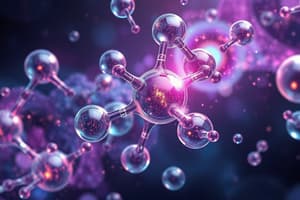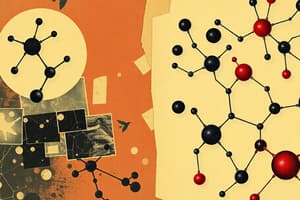Podcast
Questions and Answers
What best defines a molecule?
What best defines a molecule?
- A substance made up of charged particles.
- The smallest unit of a chemical compound that retains its chemical properties. (correct)
- A grouping of atoms that cannot be broken down by chemical means.
- A combination of two or more elements that always exist in a solid state.
Which of the following statements is NOT true about molecules?
Which of the following statements is NOT true about molecules?
- Molecules hold the chemical properties of the substances they represent.
- Molecules are made up of atoms.
- Molecules can consist of the same or different elements.
- All molecules are visible to the naked eye. (correct)
Which of the following is an example of a molecule?
Which of the following is an example of a molecule?
- Salt, NaCl, in its ionic form
- Oxygen gas, O$_2$ (correct)
- Hydrogen ions, H$^+$
- A pure metal, such as iron
What distinguishes a molecule from an atom?
What distinguishes a molecule from an atom?
What can molecules form when chemically bonded together?
What can molecules form when chemically bonded together?
Flashcards are hidden until you start studying
Study Notes
Definition and Characteristics of Molecules
- A molecule is defined as two or more atoms chemically bonded together, representing the smallest fundamental unit of a chemical compound.
- Molecules can consist of the same type of atoms (e.g., O2) or different types (e.g., H2O).
True and False Statements About Molecules
- Some statements about molecules may include their composition, behavior in reactions, or bonding characteristics.
- Identifying incorrect statements about molecules is essential for a clear understanding of chemical principles.
Examples of Molecules
- Common examples of molecules include water (H2O), carbon dioxide (CO2), and oxygen (O2).
- Identifying examples helps illustrate the concept of molecular formation and types.
Distinctions Between Molecules and Atoms
- Atoms are the basic units of matter, while molecules are formed when two or more atoms bond together.
- Molecules can be made up of the same or different kinds of atoms, whereas an atom cannot be broken down into smaller units by chemical means.
Chemical Bonding and Molecular Structures
- Molecules can combine through various types of chemical bonds (e.g., ionic, covalent) to form larger structures or compounds.
- Larger molecular structures can have significant properties and functions, critical in biological, chemical, and physical processes.
Studying That Suits You
Use AI to generate personalized quizzes and flashcards to suit your learning preferences.




